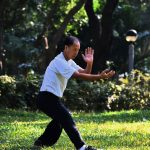
Comparing Qigong to Yoga: A Journey Through Movement and Mindfulness
9 January 2025
Comparison of Dao Yin, Qigong, and Tai Chi
27 March 2025Comparing Modern Biomedicine and Traditional Chinese Medicine: A Holistic Perspective
When it comes to healthcare and healing, two dominant paradigms stand out: modern biomedicine and traditional Chinese medicine (TCM). Both systems have evolved over centuries and offer distinct approaches to understanding and treating health conditions. While they often appear to be at odds, a closer examination reveals their unique strengths and potential for synergy.
Foundations and Philosophy
Modern Biomedicine:
- Rooted in scientific research and evidence-based practices, modern biomedicine emphasizes the study of anatomy, physiology, and pathology.
- It operates on a biomedical model, viewing the body as a machine with individual parts that can be repaired or replaced.
- Disease is often seen as a result of external pathogens, genetic predispositions, or lifestyle factors.
- Treatment focuses on eliminating symptoms or curing disease using medications, surgery, or other technological interventions.
Traditional Chinese Medicine (TCM):
- Grounded in Taoist philosophy and ancient traditions, TCM views the body as an interconnected whole.
- It emphasizes the balance of Qi (vital energy), Yin and Yang, and the harmony of the body with its environment.
- Disease is seen as a disruption in energy flow or imbalance in the body’s systems.
- Treatment focuses on restoring balance through methods like acupuncture, herbal medicine, Qigong, and dietary therapy.
Approach to Diagnosis
Modern Biomedicine:
- Relies on advanced diagnostic tools such as blood tests, imaging (X-rays, MRIs, CT scans), and genetic analysis.
- Diagnoses are precise, often categorizing diseases based on standardized criteria (e.g., ICD codes).
- Focuses on identifying the specific cause of a condition to target it directly.
Traditional Chinese Medicine:
- Uses a holistic diagnostic approach, considering physical, emotional, and environmental factors.
- Techniques include pulse diagnosis, tongue observation, and questioning about lifestyle and emotions.
- Instead of isolating a single cause, it assesses patterns of imbalance in the whole person.
Treatment Methods
Modern Biomedicine:
- Medications: Synthetic drugs target specific symptoms or pathogens (e.g., antibiotics, painkillers).
- Surgery: Advanced techniques address structural problems, such as removing tumors or repairing injuries.
- Technology: Innovations like robotic surgery and personalized medicine are hallmarks of modern practice.
- Strengths: Effective for acute conditions, trauma, and life-threatening diseases.
Traditional Chinese Medicine:
- Acupuncture: Stimulates specific points on the body to regulate Qi and alleviate symptoms. Research conducted by RMIT in the Emergency Department of Northern Hospital (Victoria, Australia) demonstrated significant positive outcomes for using acupuncture to treat acute back pain and knee pain, though findings for migraines were less conclusive (Xu et al., 2019).
- Herbal Medicine: Uses combinations of natural substances to address imbalances.
- Lifestyle Adjustments: Incorporates dietary changes, exercise (e.g., Tai Chi, Qigong), and emotional balance.
- Strengths: Excels in managing chronic conditions, preventative care, and promoting overall wellness.
View of the Patient
Modern Biomedicine:
- Views patients primarily through the lens of their disease or condition.
- Treatments are often standardized based on population-level research.
- Focus is on curing or managing the illness.
Traditional Chinese Medicine:
- Treats patients as unique individuals, tailoring treatments to their specific constitution and life circumstances.
- Focuses on supporting the body’s innate ability to heal itself and maintaining long-term balance.
- The patient’s role in their healing journey (e.g., adopting healthier habits) is emphasized.
Strengths and Limitations
Modern Biomedicine:
- Strengths:
- Highly effective in emergencies and acute care.
- Rapid advancements in technology and pharmaceuticals.
- Precise diagnostics and targeted interventions.
- Limitations:
- May overlook the emotional and holistic aspects of health.
- Can over-rely on medications or invasive procedures.
- Chronic conditions often require symptom management rather than resolution.
Traditional Chinese Medicine:
- Strengths:
- Addresses root causes and promotes long-term wellness.
- Focuses on prevention and individualized care.
- Minimal side effects when practiced correctly.
- Limitations:
- Slower results for some acute or life-threatening conditions; however, acupuncture has shown effectiveness in certain acute conditions such as back pain and knee pain.
- Limited by the variability in practitioner skill and training.
- Scientific evidence for some practices is still evolving.
Integration for Comprehensive Care
In recent years, there has been growing interest in integrative medicine, which combines the strengths of modern biomedicine and TCM. Examples include:
- Using acupuncture to alleviate side effects of chemotherapy.
- Combining herbal remedies with conventional treatments for chronic pain.
- Employing mindfulness practices (like Qigong) alongside psychological therapy for anxiety.
By appreciating the unique contributions of each system, patients and practitioners can create more effective and holistic treatment plans.
Conclusion
Modern biomedicine and traditional Chinese medicine represent two distinct yet complementary approaches to health. While modern biomedicine excels in acute care and technological innovation, TCM shines in prevention and holistic healing. Recognizing their respective strengths and integrating them thoughtfully can provide the best of both worlds, ensuring a more balanced and patient-centered healthcare experience.
References
Xu, J., Zhang, Q., & Lee, A. (2019). Acupuncture for acute pain management in the Emergency Department: A pilot study. RMIT University and Northern Hospital, Victoria, Australia.

